San Pedro Fish Market is leaving its longtime harbor home. What happens next?
One of the top-grossing restaurants in the country is an unassuming family-run business perched on the edge of the main channel of the Port of Los Angeles, with views across the water of fat oil storage tanks and sky-high green cranes servicing heavily laden cargo ships.
Far from the glamorous yacht docks of Newport Beach and Marina del Rey, the San Pedro Fish Market & Restaurant quietly built up a loyal following that spent about $30 million a year before the pandemic on its heaping trays of shrimp, lobster and other seafood shared at spare metal tables on a weathered wooden pier.
The sprawling restaurant complex with seating for 3,000 is a longtime favorite of Latino families enjoying group outings and more recently has gained popularity among social media posters in search of decadent food images to juice their feeds.
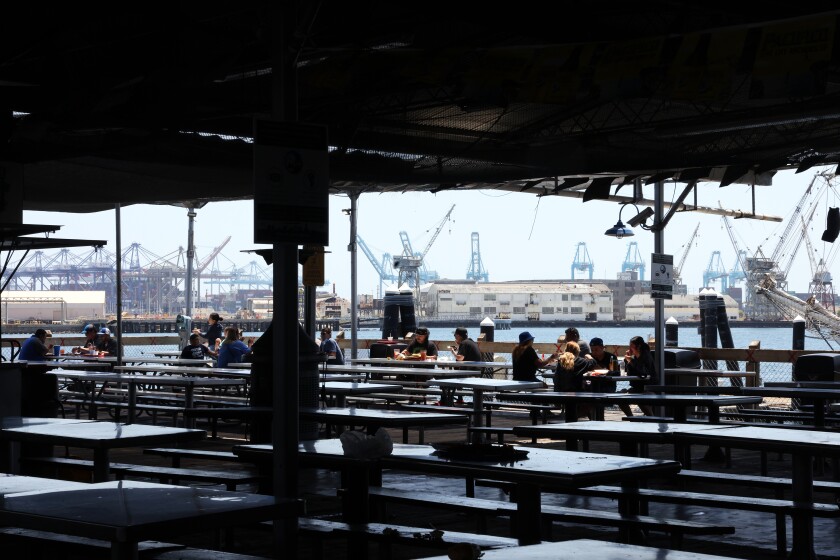
People eat outside on the dock at the San Pedro Fish Market last month.
(Dania Maxwell / Los Angeles Times)
Like most restaurants, San Pedro Fish Market took a beating as COVID-19 precautions choked off the flow of customers, but its owners expect a strong comeback — at least until they have to shut down their longtime home for good. After six decades on the pier where the Ports O’ Call tourist attraction once stood, the fish market must move to make way for new waterfront development.
The owners of the development called West Harbor tried to strike a deal to keep the Fish Market operators in the new food and entertainment-centered complex that will replace Ports O’ Call, but their visions of the role the popular restaurant would play in West Harbor were too far apart. In short, the owners of the Fish Market wanted more room than they could get.
“The problem for us is we’ve grown so much,” said Mike Ungaro, chief executive of San Pedro Fish Market and part of the third generation running the family business. “We’ve gotten too big” to fit into a restaurant space in West Harbor.
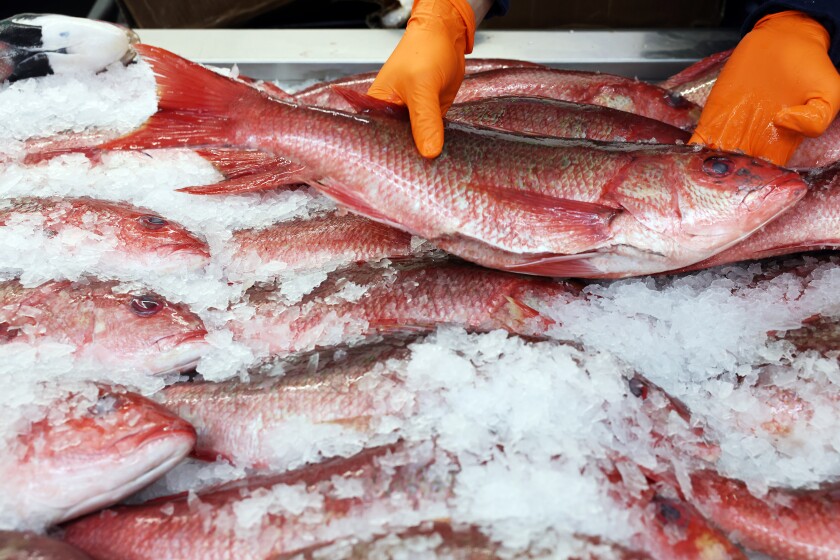
Steve Ortiz places freshly caught snapper out for sale at the San Pedro Fish Market.
(Dania Maxwell / Los Angeles Times)
In an ordinary year, the Fish Market sells about 200 tons of shrimp, which is its main draw, he said. Over a long weekend such as Memorial Day, the restaurant sells about 200 barrels of beer — a lot of it as part of the restaurant’s signature michalada recipe — as many as 15,000 loaves of garlic bread and 30,000 tortillas. The wait to get in on busy days can be two hours.
Credit card holders’ ZIP Codes suggest that the majority of customers come from within 100 miles, but people also drive in from San Diego, Palm Springs and even Phoenix and Las Vegas, Ungaro said. The social media-driven crowd is another matter, casting a wide net since the restaurant was reported to be one of the top 10 most Instagrammed restaurants in the country.
“People saw it and flew in for the weekend” before the pandemic hit, he said. “The millennial crowd was flying in from every single state.”
Customers typically customize their orders by selecting portions of uncooked seafood at the fish market to be prepared into menu items that include what the website highlights as the World Famous Shrimp Tray.
Ungaro’s team decided to shoot for a simplified bigger-is-better social media sweet spot by introducing the Super Tray with lobster, a whole fish, fish filets, vegetables, potatoes and garlic bread. It’s about $140 and should feed at least four.
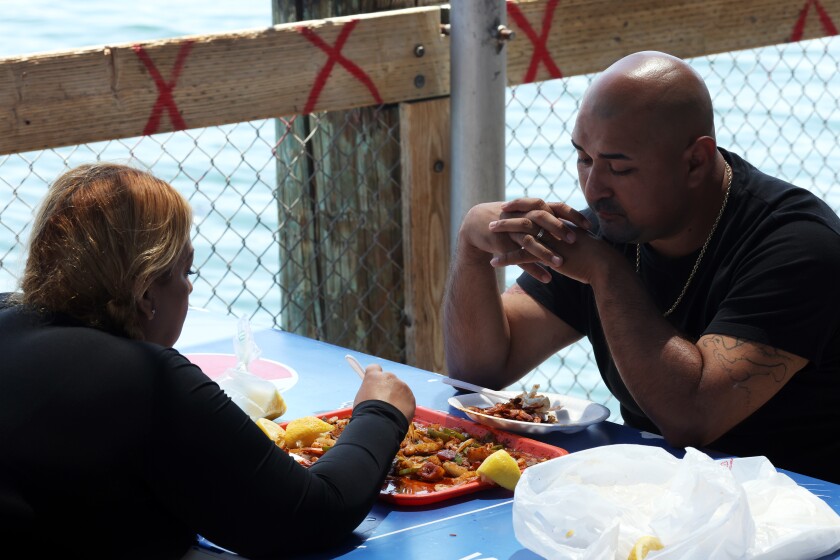
People eat outside on the dock at the San Pedro Fish Market, one of the top 10 restaurants in the country based on sales.
(Dania Maxwell / Los Angeles Times)
Ungaro and his family want to supersize the restaurant next and create one of the largest dining establishments in the U.S., capable of seating 5,500 people. Rick McCormack, a restaurant designer working on concepts for the project, likened the scale to “20 Cheesecake Factories sitting in one spot.”
Plans call for a three-level indoor and outdoor establishment with a kitchen on each floor, numerous bars and a tall wheel-shaped attraction that would offer riders views of the harbor and San Pedro and serve as a beacon for the Fish Market.
If approved by multiple government authorities, it would be located about a mile and a half north at Berth 93 adjacent to the Catalina Express shuttle to Santa Catalina Island and the World Cruise Center, where cruise lines including Carnival, Cunard and Princess Cruises dock behemoth passenger ships.
The Los Angeles Board of Harbor Commissioners this month reached a nonbinding agreement with the Fish Market on terms of occupancy for the new location. The planned terms, such as rent to be paid to the port, are not yet public.
Preliminary design ideas reflect the grand scale Ungaro and his family members hope to achieve with the 200,000-square-foot complex, which would be almost four times as big as the current location. It would cost more than $140 million to build and employ about 500 workers. Ungaro hopes it will draw 3.5 million visitors a year, up from the 2 million who stopped by each year before the pandemic.
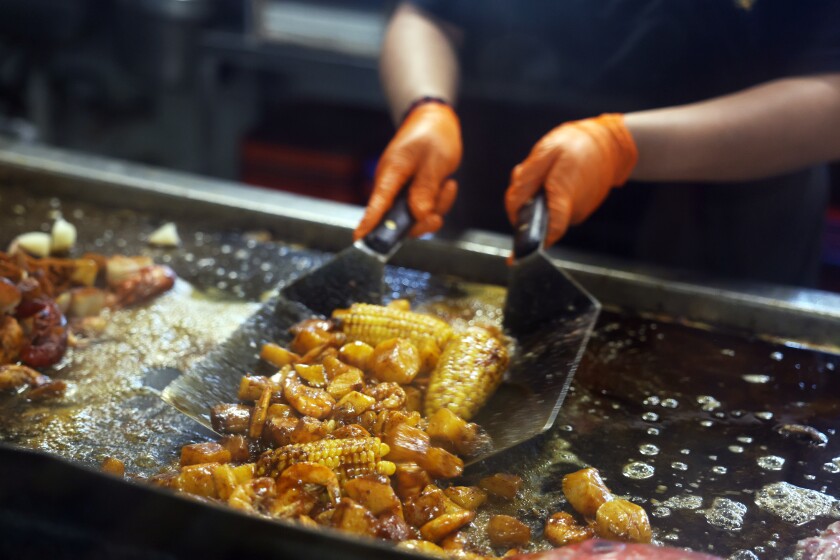
Food is prepared at the San Pedro Fish Market, which drew 2 million visitors a year before the pandemic.
(Dania Maxwell / Los Angeles Times)
“I don’t think any of us involved in this project have ever worked on a restaurant even close to this size,” said McCormack, who was head of design for Cheesecake Factory Inc. before founding Studio McCormack in Costa Mesa.
“It’s really an entertainment complex,” he said of the planned new Fish Market. “The hope is that a family can spend the whole day there and be entertained and well fed.”
Key to the entertainment would be the wheel attraction, anticipated to stand more than 10 stories high, said Bill Butler of Garner Holt Productions, a Redlands firm that has worked on attractions at Walt Disney Co. theme parks and Knott’s Berry Farm.
Designs for the Fish Market are in preliminary stages, but the wheel “would be very visible from the freeway coming in, with a lot of theming, lighting and decor,” Butler said.
Other entertainment elements will be planned as the shape of the restaurant complex becomes clear, company founder Garner Holt said, and Ungaro is committed to making the new Fish Market more than a place to eat.
“When people drive 100 miles you have to give them something else to do,” Ungaro said, such as rides and video games.
Unfortunately for the Fish Market, the path to opening a new restaurant is a long one that includes getting approvals from port officials, the City Council and the California Coastal Commission. A full environmental impact report on the potential effects of the development will be required.
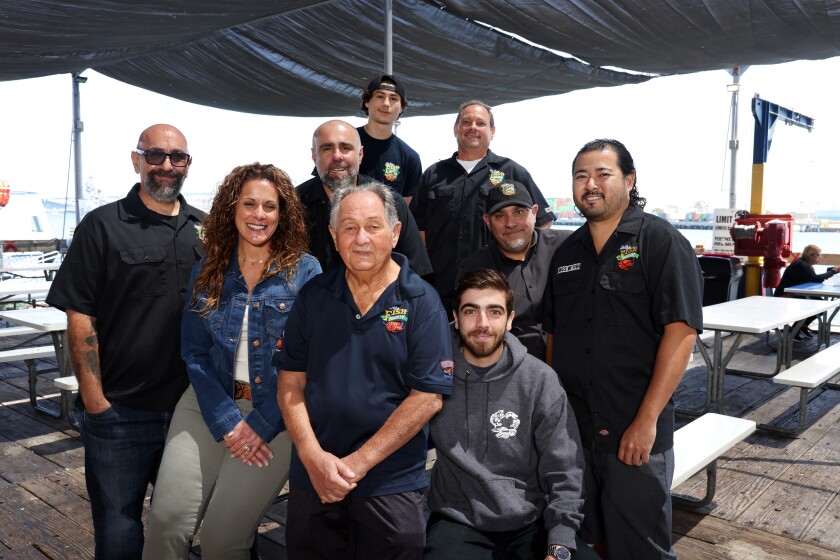
The Ungaro and Amalfitano families pose for a portrait at their restaurant. The family business started in 1956.
(Dania Maxwell / Los Angeles Times)
Ungaro hopes to get a new Fish Market up and running in less than five years, but has almost no chance of keeping the existing restaurant running that long.
When work starts on West Harbor, now scheduled for later this year, the Fish Market will have to clear out to make way for improvements to the shoreline by the port that are already partially complete, including a waterfront promenade.
The Fish Market could operate in temporary quarters at a yet-to-be-determined location until the new restaurant is ready, said Mike Galvin, director of the port’s real estate operations, who supports the Fish Market’s move to Berth 93, where the port would remain its landlord.
“It would be phenomenal to capture them in a larger development where they are able to grow their brand more, following the exponential growth over the last decade,” Galvin said. “We really want to do everything we can to maintain a partnership with the Fish Market.”
But, he added, “all that being said, there are a lot of steps that need to be resolved. There is a long entitlement process to build on the waterfront.”
The Fish Market’s planned move has backing from City Councilman Joe Buscaino, who grew up in San Pedro and worked at the Fish Market when he was in high school in the early 1990s, cooking shrimp and fajitas.
The success of the Fish Market’s founding Ungaro and Amalfitano families was a source of local pride, especially to Italian immigrant families such as Buscaino’s, he said: “They put San Pedro on the map.”
The founders definitely have a colorful past. Ungaro’s grandfather Mackey Ungaro started the family business in 1956 selling fish to locals as a front “to show income for other things he was doing,” Ungaro said, such as taking illegal sports bets as a bookie.
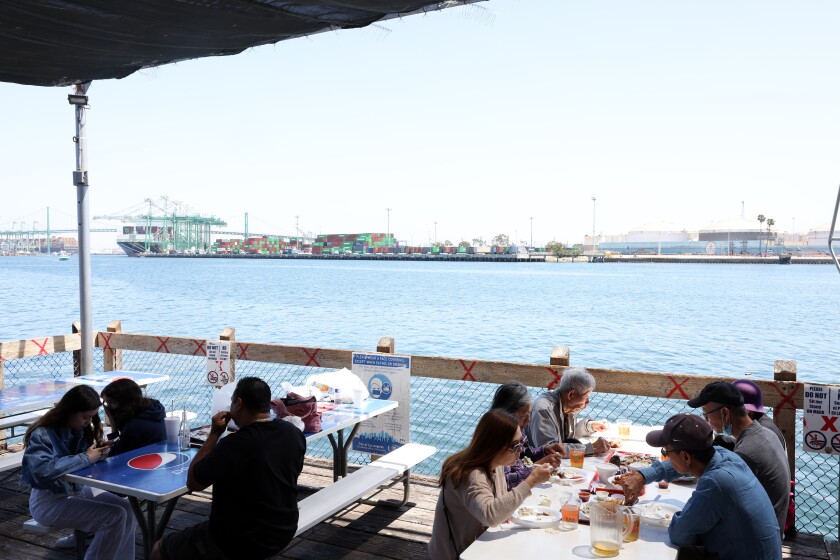
The current location opened in 1982 and expanded in 1990 with the acquisition of neighboring competitor Crusty Crab.
(Dania Maxwell / Los Angeles Times)
Mackey put his son, Henry Ungaro, and nephew, Tommy Amalfitano, in charge when they were just 15 years old. The pair made the business a success in its own right and moved it to the waterfront in 1959. The current location opened in 1982 and expanded in 1990 with the acquisition of neighboring competitor Crusty Crab.
Restaurants that survive to the third generation of leadership are unusual, retail consultant Phil Colicchio of Cushman & Wakefield said.
“It’s a high-risk industry,” he said, where 20% of newcomers don’t make it through the first year. “To find a group that has not only survived but thrived and become iconic is the rarest of the rare.”
Surviving the pandemic was hard for most restaurants, Colicchio said.
“There was no way to prepare for the asteroid that hit the hospitality industry in March 2020,” he said, and the loss of business was especially hard on independent restaurants not backed by corporate financial reserves.
Sales at the Fish Market fell 90% early in the pandemic and 350 of the restaurant’s 400 employees were furloughed, Ungaro said. Revenue is now back to about 80% of what it was.
Colicchio said the Fish Market’s pre-COVID sales of about $30 million are “astounding” and indicate that the owners “are running a highly profitable business.”
The Fish Market has a satellite restaurant in Long Beach and three smaller “grilles” in Wilmington, Harbor City and Rolling Hills Estates. The Rolling Hills Estates outpost is temporarily closed and other branches have limited hours “because we haven’t been able to find anyone to hire,” Ungaro said. He hopes to reopen in Rolling Hills Estates by September.
Buscaino, who favors the shrimp tray with octopus and sausage, wants to see the Fish Market carry on in a new location and said port officials should act quickly to make it happen.
“We’ve got to get this done in record time,” the councilman said. “We’re talking about the Disneyland of seafood, and we’ve got to move with urgency.”
